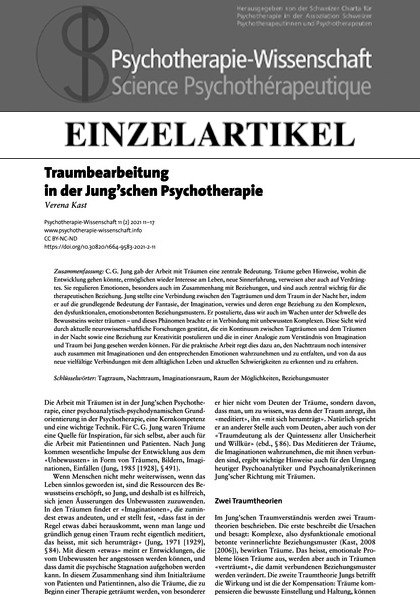Dream analysis in Jungian psychotherapy
DOI:
https://doi.org/10.30820/1664-9583-2021-2-11Keywords:
day dream, night dream, imagination space, space of possibilities, relationship patternsAbstract
C. G. Jung assigned central importance to the analysis of dreams. Dreams provide indications of where development could go, enable renewed interest in life, new experience of meaning, but also indicate what may have been repressed. They regulate emotions, especially in the context of relationships, and are also centrally important for the therapeutic relationship. Jung established a link between daydreams and dreaming at night by referring to the fundamental importance of fantasy (imagination), and its close relationship to complexes, to the dysfunctional, emotional patterns of relating. He postulated that we continue to dream below the threshold of consciousness even when awake – and he related this phenomenon to unconscious complexes. This view is supported by recent neuroscientific research that postulates a continuum between daydreaming and dreaming at night, as well as a relationship to creativity, and can be seen as analogous to Jung’s understanding of imagination and dreaming. For practical work, this suggests perceiving and developing night dreams even more intensively together with imagination and the corresponding emotions, and from there to recognize and experience a new variety of connections with everyday life and current difficulties.
Downloads
Published
2021-10-13
How to Cite
Kast, V. (2021). Dream analysis in Jungian psychotherapy. Psychotherapie-Wissenschaft, 11(2), 11–17. https://doi.org/10.30820/1664-9583-2021-2-11
Issue
Section
Special Issue
License
Copyright (c) 2021 Verena Kast

This work is licensed under a Creative Commons Attribution-NonCommercial-NoDerivatives 3.0 Unported License.
This journal provides open access to its content in accordance with the basic premise that the free public availability of research benefits the exchange of knowledge throughout the world.
Authors wishing to publish in this journal agree to the following:
- The author/s retain/s the copyrights and consent/s to initial publication of the work in the journal under a Creative Commons Attribution licence, which allows third parties to use the work by citing the name/s of the author/s and this journal as initial publisher (in accordance with the Creative Commons Attribution-NonCommercial-NoDerivs 3.0 DE-Licence).
- The author/s can enter into additional contracts for the non-exclusive distribution (e.g. publish in a collection or book) of the version published in the journal, if the journal is cited as initial publisher.


